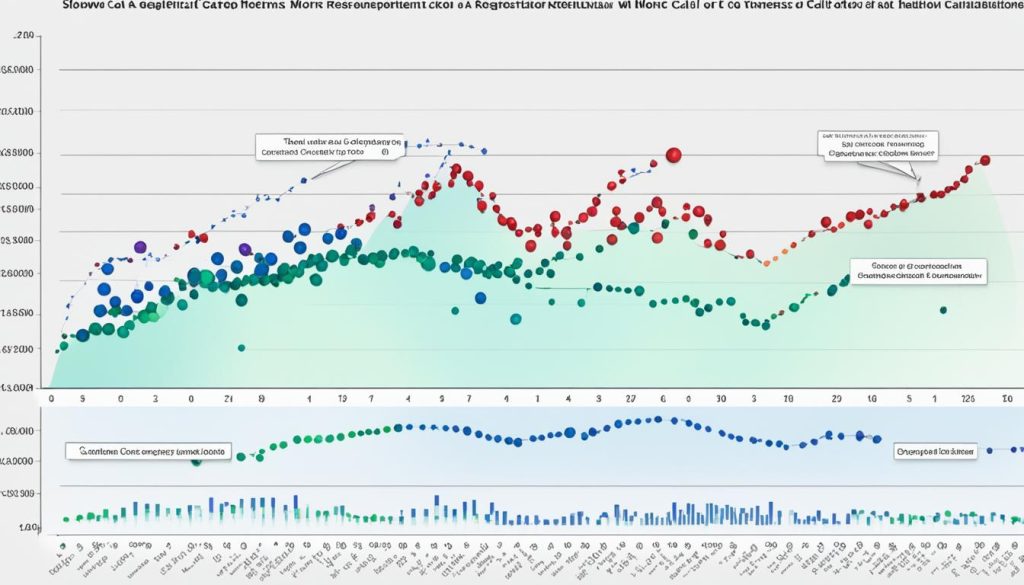As an investor, you face the challenge of the financial markets’ complexity. Uncertainty and risk can greatly affect your portfolio. Luckily, you have a powerful tool: Monte Carlo simulation. This method helps you model your investment decisions’ outcomes. It lets you make better choices and reach your financial goals1.
Monte Carlo simulation is a flexible method that creates thousands of possible scenarios. Each scenario has its own set of outcomes. By running these simulations, you understand the risks and rewards of your investments12. This helps you make smarter decisions, tweak your strategy, and boost your chances of success over time.
Key Takeaways
- Monte Carlo simulation generates thousands of possible outcomes to help you make better-informed decisions.
- The technique allows you to assess the impact of uncertainty and risk on your investment portfolio.
- Financial advisors and portfolio managers use specialized software to create Monte Carlo simulations for investment decisions.
- Monte Carlo simulation provides a probabilistic framework for understanding the range of potential outcomes and their likelihood.
- The method can be applied to a variety of financial activities, including forecasting corporate income and retirement planning.
What Is a Monte Carlo Simulation?
A Monte Carlo simulation is a method to predict outcomes in complex processes with random variables3. It’s used in investing, business, physics, and engineering to handle risk and uncertainty3. For example, telecom companies use it to improve network performance3. Insurers use it to understand risks and set policy prices3.
This method works by giving different values to uncertain variables and averaging the results34. It’s about sampling random variables to forecast outcomes, not just using fixed values4. This gives a detailed look at possible outcomes and their chances4.
A Versatile Technique
Monte Carlo simulations are used in many areas35. Investment experts use them to check default risks and study derivatives3. Financial planners predict the chance of clients outliving their money in retirement with these simulations3. They’re also used in fields like meteorology, astronomy, and physics3.
The name “Monte Carlo” comes from the famous casino city3. Stanislaw Ulam and John Von Neumann developed it during the Manhattan Project34. Now, it’s often combined with artificial intelligence for better insights3.
“Monte Carlo simulations are a powerful tool for modeling the probability of different outcomes in a process that cannot easily be predicted due to the intervention of random variables.”
| Key Principles of Monte Carlo Simulations | Applications of Monte Carlo Simulations |
|---|---|
|
|
Monte Carlo Simulation: A Primer
The idea of Monte Carlo simulation started in Monaco, a place known for its chance and random events. Mathematicians like Stanislaw Ulam and John Von Neumann created this method. They wanted to model the chance of different outcomes when things are uncertain6.
How Monte Carlo Simulations Work
Monte Carlo simulations deal with the fact that we can’t know the exact chance of outcomes because of random factors. They solve this by repeating random samples. Each sample gets a random value, the model is run, and then the results are averaged to get an estimate6.
The Four Steps of a Monte Carlo Simulation
- Generating a series of daily returns using past price data.
- Figuring out the drift, standard deviation, and variance of the data.
- Getting a random input to simulate how the asset’s price might move.
- Doing the calculations many times to get a range of possible outcomes6.
These steps help Monte Carlo simulations show the risks and uncertainties of different investment plans6.

“The beauty of the Monte Carlo method is that it allows you to explore the entire range of possible outcomes, not just the average or most likely scenario.”
Whether you’re an experienced investor or just starting, learning about Monte Carlo simulations can help you make better decisions. It can help you reach your financial goals7.
| Video | Duration (Seconds) | Completion Percentage |
|---|---|---|
| Monte Carlo Primer | 681.54 | 95% |
| Monte Carlo Simulation Example | 771.38 | 95% |
For more on Monte Carlo simulations, check out the videos and resources we suggest8.
Using Monte Carlo simulations means accepting the unpredictable nature of finance. This approach helps you make better decisions, manage risks, and aim for your financial goals.
Understanding Monte Carlo Simulation Results
When you run a monte carlo simulation, you get a normal distribution, or a bell curve. The middle of the curve shows the most likely return. There’s an equal chance the actual return will be higher or lower9.
The chance the actual return is close to the expected rate is 68%. It’s 95% within two standard deviations, and 99.7% within three9. But, there’s no promise the most expected outcome will happen. Monte Carlo simulations don’t consider things like macro trends or market hype, assuming a perfectly efficient market.
Advantages and Limitations of Monte Carlo Simulations
Monte Carlo simulations are great because they test many random variables and average them. This gives a better look at possible outcomes and their chances9.
But, they’re not perfect. They depend on the accuracy of the input and can be affected by changes in those assumptions. They also ignore unexpected events or black swan scenarios9.
To make the most of Monte Carlo simulations, understand the specific financial model or investment scenario9. Knowing about the normal distribution curve and its probabilities helps with risk assessment and financial modeling.
“Monte Carlo simulations are a powerful tool, but they should be viewed as a complement to, not a replacement for, other analytical methods. The key is to use them judiciously and in conjunction with a broader understanding of the market and the underlying drivers of performance.”
Monte Carlo Simulation: A Powerful Tool for Financial Decisions
Monte Carlo analysis is a key tool for making smart financial choices. It looks at many possible outcomes to understand the risk and uncertainty in investments. This helps investors and advisors make better decisions10.
Monte Carlo simulations do more than just look at risks. They help with optimizing resource allocation and reaching financial goals. For example, they can show the best mix of debt repayment, stock market investments, and retirement savings10.
Legacy Planning and Generational Wealth Transfer
Monte Carlo simulations are also great for legacy planning. They give insights into what assets you can leave to your heirs. By considering things like reinvestment rates, inflation, and taxes, you can plan better for passing on wealth10.
“The Monte Carlo simulation assists in determining probabilities related to running out of funds before death (longevity risk) in retirement planning scenarios.”10
When dealing with investment risks, improving your financial plan, or planning for your family’s future, Monte Carlo simulation is a valuable tool. It helps you make complex financial decisions with more confidence and clarity10.

Monte Carlo Simulation and the Impact of Early-Life Purchases
Starting a family, funding education, and buying a home early in life can greatly affect your future finances. Luckily, Monte Carlo simulation can help you understand these effects. It lets you see how different choices might turn out, helping you make better decisions.
Monte Carlo simulations model the uncertainty of outcomes, giving you a range of possible results11. By running many simulations, you learn about the chances of different financial outcomes. For example, it shows how likely you are to have enough money for retirement11.
For early-life purchases, Monte Carlo analysis is very useful. It shows how things like childcare costs, education, and owning a home affect your future wealth. This insight is key as you make choices that will impact your financial future.
| Expense | Average Annual Cost | Estimated Lifetime Cost |
|---|---|---|
| Childcare | $10,000 | $180,000 |
| College Tuition | $25,000 | $100,000 |
| Mortgage | $15,000 | $450,000 |
Using Monte Carlo simulations, you can make smarter choices about your future. This helps you work towards goals like building wealth, planning for retirement, or securing your family’s finances1112.
“The value of Monte Carlo simulations lies in providing nuanced answers to financial questions, rather than a single, deterministic response.”
Remember, early-life purchases can significantly shape your financial path. Monte Carlo simulation is a powerful tool to guide you through these decisions with confidence11.
Conclusion
Understanding the long-term effects of your early-life purchases and financial choices is key in personal finance. Monte Carlo analysis is a powerful tool to help you see the possible outcomes of your choices. This lets you make decisions that match your goals and values13.
Investors, financial advisors, and portfolio managers can use this method to feel more confident in their financial planning. It helps secure their financial future and builds a legacy for future generations13. Monte Carlo simulations help you understand risk and uncertainty in investments. They show how to best use your resources and reach your financial goals14.
Monte Carlo simulations give you the power to make better financial choices. They help you manage risk and build a secure financial future for you and your loved ones1314.
FAQ
What is a Monte Carlo simulation?
A Monte Carlo simulation is a way to deal with uncertainty in investing and other areas. It looks at a range of possible outcomes and their chances of happening.
How do Monte Carlo simulations work?
These simulations tackle the challenge of not knowing the exact outcome due to random factors. They repeat random samples, give a random value to uncertain variables, run the model, and average the results for an estimate.
What are the key principles and applications of Monte Carlo simulations?
The main idea is to give different values to uncertain variables for various results and then average them for an estimate. These simulations help solve problems in investing, business, physics, and engineering.
How are Monte Carlo simulation results interpreted?
The results form a normal distribution, like a bell curve. The most likely outcome is in the middle. There’s a 68% chance the actual result will be close to this. The chances increase to 95% and 99.7% for results within two and three standard deviations, respectively.
What are the advantages and limitations of Monte Carlo simulations?
They’re great for testing random variables and averaging them, unlike other methods. But, they don’t consider things like macro trends or market hype, assuming a perfectly efficient market.
How can Monte Carlo analysis be used in financial decision-making?
It’s useful for making complex financial decisions by looking at many possible outcomes. This helps in understanding risks and uncertainties in investments. It also helps in deciding how to allocate resources, like between debt, stocks, and retirement savings.
How can Monte Carlo simulations help with early-life financial decisions?
These simulations help see the effects of early decisions like starting a family or buying a home. They show how these choices might impact your financial future. This helps in making decisions that fit your goals and values.
Source Links
- Understanding How the Monte Carlo Method Works
- Power of Monte Carlo Simulation in Risk Analysis
- Monte Carlo Simulation: What It Is, How It Works, History, 4 Key Steps
- What Is Monte Carlo Simulation? | IBM
- Monte Carlo method
- Wagner Math Finance Monte Carlo Primer Page
- The Science and Business of Biotechnology
- Healthcare Finance
- Understanding Monte Carlo Simulations
- What Can The Monte Carlo Simulation Do For Your Portfolio?
- What Is A Monte Carlo Simulation And How Does It Impact My Financial Plan?
- Monte Carlo Simulations: Forecasting Folly?
- Monte Carlo Simulation Application, and Pros & Cons | Spiceworks – Spiceworks
- Monte Carlo Simulations: A Tool for Predictive Analysis and Informed Decision Making – Recast

